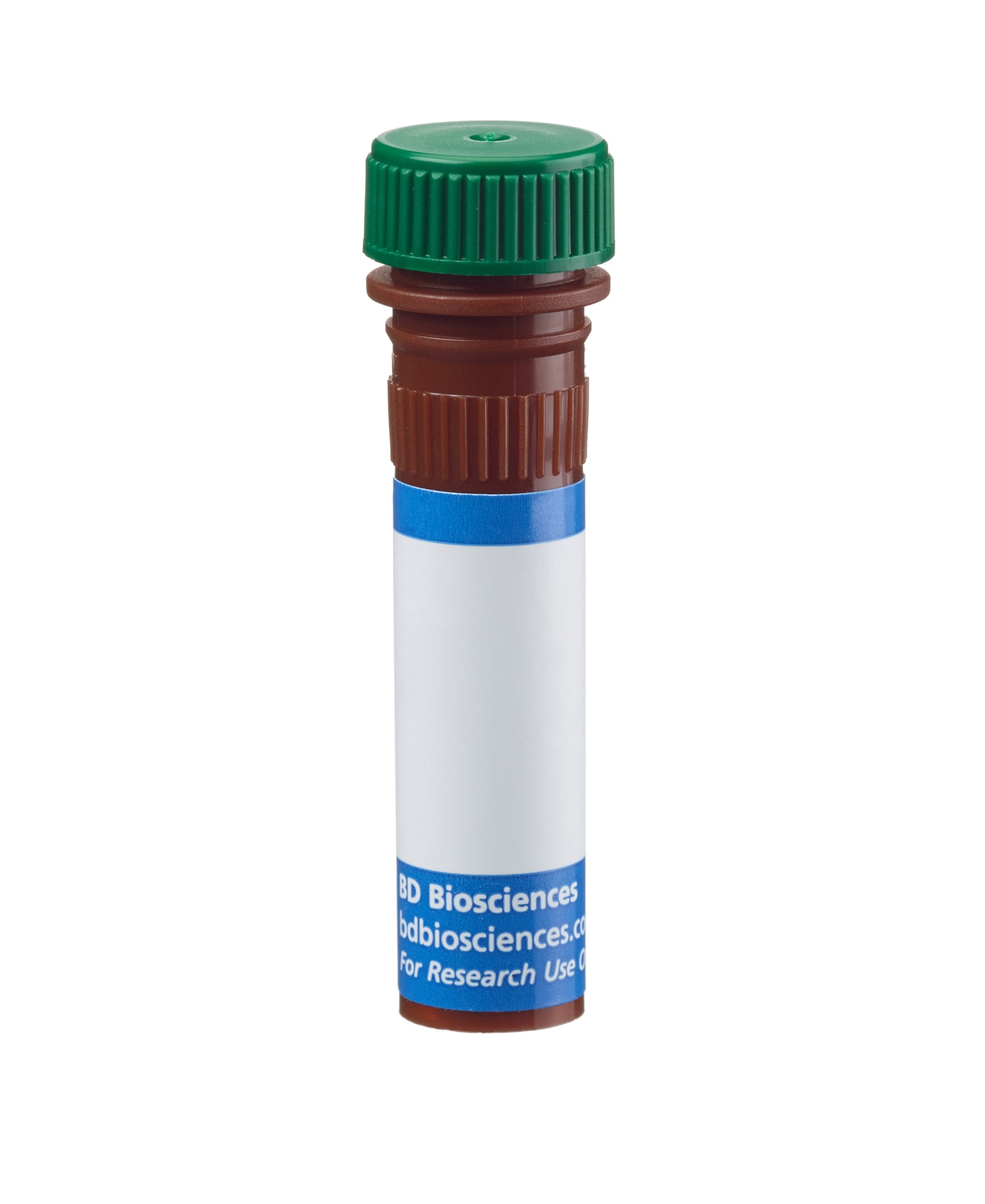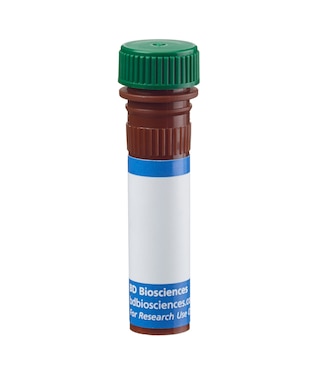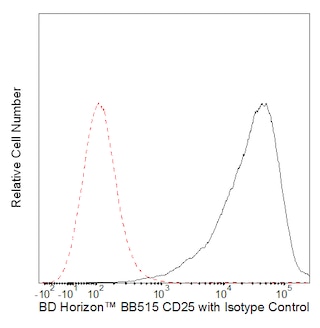Old Browser
This page has been recently translated and is available in French now.
Looks like you're visiting us from {countryName}.
Would you like to stay on the current country site or be switched to your country?




Flow cytometric analysis of CD25 expression on unstimulated and stimulated human peripheral blood lymphocytes. Left and Middle Panels: Human whole blood was stained with either BD Horizon™ BB515 Mouse IgG1, κ Isotype Control (Cat. No. 564416; Left Panel) or BD Horizon BB515 Mouse Anti-Human CD25 antibody (Cat. No. 564467/564468; Middle Panel). Erythrocytes were lysed with BD FACS Lysing Solution (Cat. No. 349202). Two-color flow cytometric contour plots showing the correlated expression patterns for Ig Isotype control staining (Left Panel) or CD25 expression (Middle Panel) versus Autofluorescence were generated for events with the forward and side light- scatter characteristics of intact lymphocytes. Right Panel: Human peripheral blood mononuclear cells were stimulated for 3 days with Phytohemagglutinin. The cells were stained with either BD Horizon™ BB515 Mouse IgG1, κ Isotype Control (dashed line histogram) or BD Horizon BB515 Mouse Anti-Human CD25 antibody (solid line histogram). The fluorescence histograms were derived from events with the forward and side light-scatter characteristics of viable lymphoblasts. Flow cytometric analysis was performed using a BD™ LSR II Flow Cytometer System.


BD Horizon™ BB515 Mouse Anti-Human CD25

Regulatory Status Legend
Any use of products other than the permitted use without the express written authorization of Becton, Dickinson and Company is strictly prohibited.
Preparation And Storage
Recommended Assay Procedures
BD™ CompBeads can be used as surrogates to assess fluorescence spillover (Compensation). When fluorochrome conjugated antibodies are bound to CompBeads, they have spectral properties very similar to cells. However, for some fluorochromes there can be small differences in spectral emissions compared to cells, resulting in spillover values that differ when compared to biological controls. It is strongly recommended that when using a reagent for the first time, users compare the spillover on cells and CompBead to ensure that BD Comp beads are appropriate for your specific cellular application.
For optimal results, it is recommended to perform 2 washes after staining with antibodies. Cells may be prepared, stained with antibodies and washed twice with wash buffer per established protocols for immunofluorescence staining, prior to acquisition on a flow cytometer. Performing fewer than the recommended wash steps may lead to increased spread of the negative population.
For optimal and reproducible results, BD Horizon Brilliant Stain Buffer should be used anytime two or more BD Horizon Brilliant dyes are used in the same experiment. Fluorescent dye interactions may cause staining artifacts which may affect data interpretation. The BD Horizon Brilliant Stain Buffer was designed to minimize these interactions. More information can be found in the Technical Data Sheet of the BD Horizon Brilliant Stain Buffer (Cat. No. 563794/566349) or the BD Horizon Brilliant Stain Buffer Plus (Cat. No. 566385).
Product Notices
- This reagent has been pre-diluted for use at the recommended Volume per Test. We typically use 1 × 10^6 cells in a 100-µl experimental sample (a test).
- An isotype control should be used at the same concentration as the antibody of interest.
- Caution: Sodium azide yields highly toxic hydrazoic acid under acidic conditions. Dilute azide compounds in running water before discarding to avoid accumulation of potentially explosive deposits in plumbing.
- For fluorochrome spectra and suitable instrument settings, please refer to our Multicolor Flow Cytometry web page at www.bdbiosciences.com/colors.
- BD Horizon Brilliant Stain Buffer is covered by one or more of the following US patents: 8,110,673; 8,158,444; 8,575,303; 8,354,239.
- Please refer to www.bdbiosciences.com/us/s/resources for technical protocols.
Companion Products





The 2A3 monoclonal antibody specifically binds to human CD25, the low-affinity alpha subunit of the Interleukin-2 Receptor (IL- 2Rα). CD25 associates with CD122 (IL-2Rβ chain) and CD132 (common γ chain or γc) to form the high-affinity signal-transducing IL-2R complex. CD25 is expressed by subsets of thymocytes and peripheral blood lymphocytes including CD4+CD25+ regulatory T cells and memory T cells. CD25 antigen density increases on activated T cells including phytohemagglutinin (PHA)-, concanavalin A (Con A)-, and CD3-activated T lymphocytes. High levels of CD25 can be expressed by T lymphocytes from mixed lymphocyte cultures and by human T-lymphocyte leukemia virus (HTLV)-infected T-lymphocyte leukemia lines, for example, HUT-102. CD25 can also be expressed by activated B cells and macrophages. Recombinant IL-2 blocks the binding of the 2A3 antibody to PHA-activated T lymphocytes.
The antibody was conjugated to BD Horizon BB515 which is part of the BD Horizon Brilliant™ Blue family of dyes. With an Ex Max near 490 nm and an Em Max near 515 nm, BD Horizon BB515 can be excited by the blue laser (488 nm) laser and detected with a 530/30 nm filter. This dye has been exclusively developed by BD Biosciences and is up to seven times brighter than FITC with less spillover into the PE channel. Due to similar excitation and emission properties, BB515, FITC, and Alexa Fluor® 488 cannot be used simultaneously. It is not recommended to use BB515 in cocktails that include Streptavidin conjugates as it may cause high background.

Development References (14)
-
Annunziato F, Cosmi L, Liotta F, et al. Phenotype, localization, and mechanism of suppression of CD4(+)CD25(+) human thymocytes. J Exp Med. 2002; 196(3):379-387. (Clone-specific: Flow cytometry, Fluorescence activated cell sorting). View Reference
-
Dower SK, Hefeneider SH, Alpert AR, Urdal DL. Quantitative measurement of human interleukin 2 receptor levels with intact and detergent-solubilized human T-cells. Mol Immunol. 1985; 22(8):937-947. (Clone-specific). View Reference
-
Greene WC, Leonard WJ. The human interleukin-2 receptor. Annu Rev Immunol. 1986; 4:69-95. (Biology). View Reference
-
Lando Z, Sarin P, Megson M, et al. Association of human T-cell leukaemia/lymphoma virus with the Tac antigen marker for the human T-cell growth factor receptor. Nature. 1983; 305(5936):733-736. (Biology). View Reference
-
Leonard WJ, Depper JM, Uchiyama T, Smith KA, Waldmann TA, Greene WC. A monoclonal antibody that appears to recognize the receptor for human T-cell growth factor; partial characterization of the receptor. Nature. 1982; 300(5889):267-269. (Biology). View Reference
-
Ng WF, Duggan PJ, Ponchel F, et al. Human CD4(+)CD25(+) cells: a naturally occurring population of regulatory T cells. Blood. 2001; 98(9):2736-2744. (Biology). View Reference
-
Rambaldi A, Young DC, Herrmann F, Cannistra SA, Griffin JD. Interferon-gamma induces expression of the interleukin 2 receptor gene in human monocytes. Eur J Immunol. 1987; 17(1):153-156. (Clone-specific). View Reference
-
Robb RJ, Greene WC, Rusk CM. Low and high affinity cellular receptors for interleukin 2. Implications for the level of Tac antigen. J Exp Med. 1984; 160(4):1126-1146. (Biology). View Reference
-
Sallusto F, Lenig D, Forster R, Lipp M, Lanzavecchia A. Two subsets of memory T lymphocytes with distinct homing potentials and effector functions. Nature. 1999; 401(6754):708-712. (Biology). View Reference
-
Schwarting R, Stein H. Cluster report: CD25. In: Knapp W. W. Knapp .. et al., ed. Leucocyte typing IV : white cell differentiation antigens. Oxford New York: Oxford University Press; 1989:399-403.
-
Sereti I, Martinez-Wilson H, Metcalf JA, et al. Long-term effects of intermittent interleukin 2 therapy in patients with HIV infection: characterization of a novel subset of CD4(+)/CD25(+) T cells. Blood. 2002; 100(6):2159-2167. (Clone-specific: Flow cytometry). View Reference
-
Siegel JP, Sharon M, Smith PL, Leonard WJ. The IL-2 receptor beta chain (p70): role in mediating signals for LAK, NK, and proliferative activities. Science. 1987; 238(4823):75-78. (Biology). View Reference
-
Teshigawara K, Wang HM, Kato K, Smith KA. Interleukin 2 high-affinity receptor expression requires two distinct binding proteins. J Exp Med. 1987; 165(1):223-238. (Biology). View Reference
-
Urdal DL, March CJ, Gillis S, Larsen A, Dower SK. Purification and chemical characterization of the receptor for interleukin 2 from activated human T lymphocytes and from a human T-cell lymphoma cell line. Proc Natl Acad Sci U S A. 1984; 81(20):6481-6485. (Immunogen: Blocking, Dot Blot, Immunoaffinity chromatography, Inhibition, Radioimmunoassay). View Reference
Please refer to Support Documents for Quality Certificates
Global - Refer to manufacturer's instructions for use and related User Manuals and Technical data sheets before using this products as described
Comparisons, where applicable, are made against older BD Technology, manual methods or are general performance claims. Comparisons are not made against non-BD technologies, unless otherwise noted.
For Research Use Only. Not for use in diagnostic or therapeutic procedures.
Report a Site Issue
This form is intended to help us improve our website experience. For other support, please visit our Contact Us page.